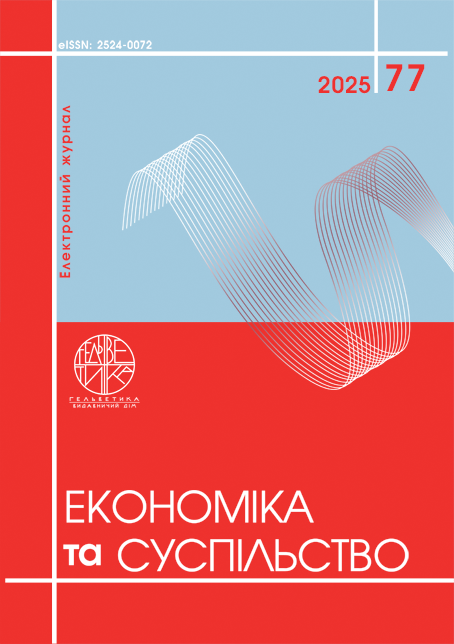TRANSFORMATION OF DISTRICT HEATING SYSTEMS: LATVIAN EXPERIENCE
Abstract
The Ukrainian energy and district heating systems have struggled to survive for the last four years of war. This forced Ukraine to reconsider its approaches to resisting threats and overcoming challenges to the critical infrastructure. These approaches are based on facility modernization, renewables usage and energy localization. Scientists and experts pointed out that these transformations should be supported by the development of market regulation instead of the current hard state regulation. The DH development of the Baltic countries can be useful for planning the Ukrainian DH renovation due to some common features. This investigation aims to analyze the key aspects of DH modernization according to the modern conditions of market and society development in large and small Latvian settlements. The study combines the use of methods of system and deductive analysis, comparative and graphical analysis. The statistical base of the study was obtained from open resources, in particular, local operators of heating networks in Riga and Salaspils. During the first decade of this century, Latvian local DH systems have been dependent on imported fossil fuels, in particular, natural gas. But due to the implementation of market competition and increasing fossil fuel prices, most settlements have succeeded in replacing them with local renewables, e.g., solid biofuel. It was noted that large settlements like Riga are limited in the use of solid biofuels due to logistical, infrastructural and environmental barriers. In contrast, small cities like Salaspils have almost completely abandoned fossil fuels. It was found that in this way, Salaspils’ DH reduced the risks of tariff fluctuations for thermal energy in conditions of price shocks on energy markets. Future reductions in heating tariffs depend not so much on the use of solid biofuels as on the introduction of solar and geothermal energy. The local DH systems of the analyzed cities have successfully modernized their heating network infrastructure, reducing heat energy losses by approximately half. A common barrier to the modernization of local DH systems in both large and small cities is a significant share of outdated buildings, the improvement of which requires substantial capital investments. The conclusions obtained within the investigation can be used for planning the national and/or local strategies of DH modernization and renovation on market-based conditions, which are crucial tasks for 2025-2026.
References
Regional energy transition outlook: European Union. IRENA. 2025. Abu Dhabi. URL: https://energypedia.info/wiki/Publication_-_Regional_energy_transition_outlook:_European_Union (дата звернення: 26.08.2025)
Jimenez Navarro J.P., Filippidou F., Kavvadias K. and Carlsson J. Efficient District Heating and Cooling. EUR 30986 EN. Publications Office of the European Union. Luxembourg. 2022. DOI: https://doi.org/10.2760/854480
Дерій В.О. Тенденції розвитку систем централізованого теплопостачання України. Проблеми загальної енергетики. 2021. Вип. 1. С. 52-59. URL: http://nbuv.gov.ua/UJRN/PZE_2021_1_8 (дата звернення: 26.08.2025)
Селіхов Ю.А., Рищенко І.М., Горбунов К.О. Інтеграція роботи системи теплопостачання. Інтегровані технології та енергозбереження. 2023. №4. С. 3-16. DOI: https://doi.org/10.20998/2078-5364.2023.4.01
Гелетуха Г.Г., Крамар В.Г., Олійник В.М., Антоненко В.О. Аналіз можливостей збереження і розвитку централізованого теплопостачання в Україні. Теплофізика та теплоенергетика. 2018. 41(1). С. 53-58. DOI: https://doi.org/https://doi.org/10.31472/ttpe.1.2019.7
Напрямки ринкових перетворень у сфері теплопостачання України : монографія / за ред. М. О. Кизима, Є. І. Котлярова. Харків : ФОП Лібуркіна Л. М., 2024. 338 с.
Гелетуха Г.Г., Желєзна Т.А., Баштовий А.І. Проблеми та перспективи довгострокового планування у секторі теплопостачання України. Теплофізика та теплоенергетика. 2019. 41(2). С. 72-77. DOI: https://doi.org//10.31472/ttpe.2.2019.10
Ющенко Н. Економічна доцільність розвитку в Україні помірно лібералізованого ринку теплової енергії. Економіка та суспільство. 2021. (23). DOI: https://doi.org/10.32782/2524-0072/2021-23-21
Бабак В., Нікітін Є., Тесленко О. Цілісний підхід до системної трансформації електроенергетики, централізованого теплопостачання та комунальної інфраструктури. Системні дослідження в енергетиці. 2024. 4 (80). С. 6-25. DOI: https://doi.org/10.15407/srenergy2024.04.006
Гламаздін П., Баранчук К., Приймак О. В. Нові підходи до організації централізованого теплопостачання. Вентиляція, освітлення та теплогазопостачання. 2021. 39. C. 38–46. DOI: https://doi.org/10.32347/2409-2606.2021.39.38-46
Савченко O.О., Юркевич Ю.С., Возняк O. T. Оцінка можливості впровадження низькотемпературних систем централізованого теплопостачання. Екологічна безпеки та природокористування. 2024. 1 (49). С. 17–33. DOI: https://doi.org/10.32347/2411-4049.2024.1.17-33
AS “Rīgas Siltums” siltumenerģijas tariffs. Rīgas Siltums. URL: https://www.rs.lv/saturs/rigas-siltums-siltumenergijas-tarifs (дата звернення: 26.08.2025)
Tariff history. For customers. Salaspils Siltums. URL: https://salaspilssiltums.lv/en/for-customers/tariff-history/ (дата звернення: 26.08.2025)
Latvia’s National Energy and Climate Plan 2021–2030. Riga. 2020. ENER-2019-00002-00-04-EN-TRA-00. URL: https://energy.ec.europa.eu/system/files/2020-04/lv_final_necp_main_en_0.pdf (дата звернення: 26.08.2025)
Heat sources and fuel diversification. About the company. Salaspils Siltums. URL: https://salaspilssiltums.lv/en/par-uznemumu/siltumavoti-un-kurinama-diversifikacija/ (дата звернення: 26.08.2025)
Ziemele J., Gravelsins A., Blumberga A., Blumberga D. Sustainability of heat energy tariff in district heating system: Statistic and dynamic methodologies. Energy. 2017. 137. pp. 834–845. DOI: https://doi.org/10.1016/j.energy.2017.04.130
Prozuments, A., Borodinecs, A., Zaharovs, S., Banionis, K., Monstvilas, E., & Norvaišienė, R. Evaluating Reduction in Thermal Energy Consumption across Renovated Buildings in Latvia and Lithuania. Buildings. 2023. 13(8). 1916. DOI: https://doi.org/10.3390/buildings13081916
Лисак О. Аналіз зміни тепловіддачі радіаторів внаслідок переходу до низькотемпературного опалення з використанням геотермальної енергії. Відновлювана енергетика. 2025. 1(80). C. 108-115. DOI: https://doi.org/10.36296/1819-8058
IRENA (2025) Regional energy transition outlook: European Union, International Renewable Energy Agency. Abu Dhabi. Available at: https://energypedia.info/wiki/Publication_-_Regional_energy_transition_outlook:_European_Union (accessed August 26, 2025)
Jimenez Navarro J. P., Filippidou, F., Kavvadias K. and Carlsson J. (2022) Efficient District Heating and Cooling. EUR 30986 EN. Publications Office of the European Union. Luxembourg. DOI: https://doi.org/10.2760/854480, JRC126522
Deriy V.O. (2021) Tendentsii rozvytku system tsentralizovanoho teplopostachannia Ukrainy [Trends of development of district heating of Ukraine]. Problemy zahalnoi enerhetyky – Problems of General Energy. No. 1, pp. 52-59. Available at: http://nbuv.gov.ua/UJRN/PZE_2021_1_8 (in Ukrainian) (accessed August 26, 2025)
Selikhov Yu. A., Ryshchenko I. M., Horbunov K. O. (2023) Intehratsiia roboty systemy teplopostachannia [Integration of heating system operation]. Intehrovani tekhnolohii ta enerhozberezhennia – Integrated Technologies and Energy Saving. No. 4, pp. 3-16. DOI: https://doi.org/10.20998/2078-5364.2023.4.01 (in Ukrainian)
Heletukha H. H., Kramar V. H., Oliinyk V. M., Antonenko V. O. (2018) Analiz mozhlyvostei zberezhennia i rozvytku tsentralizovanoho teplopostachannia v Ukraini [Analysis of the possibilities for saving and development of district heating systems іn Ukraine]. Teplofizyka ta teploenerhetyka – Thermophysics and Thermal Power Engineering. 41(1), pp. 53-58. DOI: https://doi.org/https://doi.org/10.31472/ttpe.1.2019.7 (in Ukrainian)
Kyzym, M. and Kotlyarov, Y. (2024), Napriamky rynkovykh peretvoren u sferi teplopostachannia Ukrainy: monohrafiia [Directions of marketing transformations in the heating sphere of Ukraine: monograph]. PE Liburkina L.M. Kharkiv, Ukraine, 338 p. (in Ukrainian)
Heletukha H. H., Zheliezna T. A., Bashtovyi A. I. (2019) Problemy ta perspektyvy dovhostrokovoho planuvannia u sektori teplopostachannia Ukrainy [Problems and prospects of long-term planning in the heat supply sector of Ukraine]. Teplofizyka ta teploenerhetyka – Thermophysics and Thermal Power Engineering, 41(2), pp. 72-77. Available at: https://ihe.nas.gov.ua/index.php/journal/article/view/327/269 (in Ukrainian) (accessed August 26, 2025)
Yushchenko N. (2021) Ekonomichna dotsilnist rozvytku v Ukraini pomirno liberalizovanoho rynku teplovoi enerhii [Economic feasibility of development in Ukraine moderate liberalized market of thermal energy]. Ekonomika ta suspilstvo – Economy and Society. (23). DOI: https://doi.org/10.32782/2524-0072/2021-23-21 (in Ukrainian)
Babak V., Nikitin Y., Teslenko O. (2024). Tsilisnyi pidkhid do systemnoi transformatsii elektroenerhetyky, tsentralizovanoho teplopostachannia ta komunalnoi infrastruktury [Holistic approach to the systemic transformation of the electric power industry, district heating and municipal infrastructure]. Systemni doslidzhennia v enerhetytsi – System Research in Energy. (4 (80), pp. 6-25. DOI: https://doi.org/10.15407/srenergy2024.04.006 (in Ukrainian)
Hlamazdin P., Baranchuk K., Pryimak O. V. (2021). Novi pidkhody do orhanizatsii tsentralizovanoho teplopostachannia [New approachers to organization of district heating]. Ventyliatsiia, osvitlennia ta teplohazopostachannia – Ventilation, Lightening and Heating. 39, pp. 38–46. DOI: https://doi.org/10.32347/2409-2606.2021.39.38-46 (in Ukrainian)
Savchenko O. O., Yurkevyc Y. S., Voznyak O. T. (2024). Otsinka mozhlyvosti vprovadzhennia nyzkotemperaturnykh system tsentralizovanoho teplopostachannia [Possibility assessment of the low-temperature district heating systems implementation in Ukraine]. Ekolohichna bezpeky ta pryrodokorystuvannia – Environmental Safety and Natural Resources. 49(1), pp. 17–33. DOI: https://doi.org/10.32347/2411-4049.2024.1.17-33 (in Ukrainian)
Rīgas Siltums. AS “Rīgas Siltums” siltumenerģijas tariffs. Available at: https://www.rs.lv/saturs/rigas-siltums-siltumenergijas-tarifs (accessed August 26, 2025)
Salaspils Siltums. Tariff history. Available at: https://salaspilssiltums.lv/en/for-customers/tariff-history/ (accessed August 26, 2025)
Latvia’s National Energy and Climate Plan 2021–2030. Riga, 2020. ENER-2019-00002-00-04-EN-TRA-00 – Available at: https://energy.ec.europa.eu/system/files/2020-04/lv_final_necp_main_en_0.pdf (accessed August 26, 2025)
Salaspils Siltums. Heat sources and fuel diversification. Available at: https://salaspilssiltums.lv/en/par-uznemumu/siltumavoti-un-kurinama-diversifikacija/ (accessed August 26, 2025)
Ziemele J., Gravelsins A., Blumberga A., & Blumberga, D. (2017). Sustainability of heat energy tariff in district heating system: Statistic and dynamic methodologies. Energy. 137, pp. 834–845. DOI: https://doi.org/10.1016/j.energy.2017.04.130
Prozuments A., Borodinecs A., Zaharovs S., Banionis K., Monstvilas E., & Norvaišienė R. (2023). Evaluating Reduction in Thermal Energy Consumption across Renovated Buildings in Latvia and Lithuania. Buildings. 13(8), 1916. DOI: https://doi.org/10.3390/buildings13081916
Lysak О. (2025). Analiz zminy teploviddachi radiatoriv vnaslidok perekhodu do nyzkotemperaturnoho opalennia z vykorystanniam heotermalnoi enerhii [Analysis of changes in heat output from radiators during the switch to low-temperature heating using geothermal energy]. Vidnovluvana energetika – Renewable Energy. 2025. 1(80). pp. 108-115. DOI: https://doi.org/10.36296/1819-8058 (in Ukrainian)
Copyright (c) 2025 Сергій Киризюк

This work is licensed under a Creative Commons Attribution 4.0 International License.


